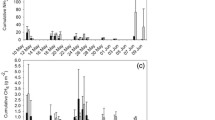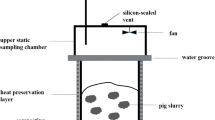Abstract
Manure storage contributes significantly to greenhouse gas (GHG), NH3 and odour emissions from intensive livestock production. A pilot-scale facility with eight 6.5-m3 slurry storage units was used to quantify emissions of CH4, N2O, NH3, and odorants from pig slurry during winter and summer storage. Pig slurry was stored with or without a straw crust, and with or without interception of precipitation, i.e., four treatments, in two randomized blocks. Emissions of total reduced S (mainly H2S) and p-cresol, but not skatole, were reduced by the straw crust. Total GHG emissions were 0.01–0.02 kg CO2 eq m−3 day−1 during a 45-day winter storage, and 1.1–1.3 kg CO2 eq m−3 day−1 during a 58-day summer storage period independent of storage conditions; the GHG balance was dominated by CH4 emissions. Nitrous oxide emissions occurred only during summer storage where, apparently, emissions were related to the water balance of the surface crust. An N2O emission factor for slurry storage with a straw crust was estimated at 0.002–0.004. There was no evidence for a reduction of CH4 emissions with a crust. Current Intergovernmental Panel on Climate Change recommendations for N2O and CH4 emission factors are discussed.




Similar content being viewed by others
Abbreviations
- VS:
-
Volatile solids
- TRS:
-
Total reduced sulphur
- TN:
-
Total nitrogen
- TAN:
-
Total ammoniacal nitrogen
- GWP:
-
Global warming potential
- GHG:
-
Greenhouse gas
- −P−S:
-
No precipitation, no straw crust
- −P+S:
-
No precipitation, straw crust present
- +P−S:
-
With precipitation, no straw crust
- +P+S:
-
With precipitation, straw crust present
References
Ambus P, Petersen SO (2005) Oxidation of 13C-labeled methane in surface crusts of pig- and cattle slurry. Isot Environ Health Stud 41:125–133
Blanes-Vidal V, Hansen MN, Adamsen APS, Feilberg A, Petersen SO, Jensen BB (2009) Characterization of odor released during handling of swine slurry: Part I. Relationship between odorants and perceived odor concentrations. Atmos Environ 43:2997–3005
Bossert ID, Young LY (1986) Anaerobic oxidation of p-cresol by a denitrifying bacterium. Appl Environ Microbiol 52:1117–1122
Chin K-J, Lukow T, Stubner S, Conrad R (1999) Structure and function of the methanogenic archaeal community in stable cellulose-degrading enrichment cultures at two different temperatures (15 and 30°C). FEMS Microbiol Ecol 30:313–326
Clemens J, Trimborn M, Weiland P, Amon B (2006) Mitigation of greenhouse gas emissions by anaerobic digestion of cattle slurry. Agric Ecosyst Environ 112:171–177
Duan Y-F, Elsgaard L, Petersen SO (2013) Inhibition of methane oxidation in slurry surface crust by inorganic nitrogen. J Environ Qual 42 (in press)
Dunfield P, Knowles R, Dumont R, Moore TR (1993) Methane production and consumption in temperate and subarctic peat soils: response to temperature and pH. Soil Biol Biochem 25:321–326
Eriksen J, Adamsen APS, Nørgaard JV, Poulsen HD, Jensen BB, Petersen SO (2010) Emissions of sulphur-containing odorants, ammonia and methane from pig slurry: effects of dietary methionine and benzoic acid. J Environ Qual 39:1097–1107
Feilberg A, Adamsen APS, Lindholst S, Lyngbye M, Schäfer A (2010) Evaluation of biological air filters for livestock ventilation air by membrane inlet mass spectrometry. J Environ Qual 39:1085–1096
Feilberg A, Nyord T, Hansen MN, Lindholst S (2011) Chemical evaluation of odor reduction by soil injection of animal manure. J Environ Qual 40:1674–1682
Forster P, Ramaswamy V, Artaxo P, Berntsen T, Betts R, Fahey DW, Haywood J, Lean J, Lowe DC, Myhre G, Nganga J, Prinn R, Raga G, Schulz M, Van Dorland R (2007) Changes in atmospheric constituents and in radiative forcing. In: Solomon S, Qin D, Manning M, Chen Z, Marquis M, Averyt KB, Tignor M, Miller HL (eds) Climate change 2007: the physical science basis. Contribution of working group I to the fourth assessment report of the intergovernmental panel on climate change. Cambridge University Press, Cambridge/New York
Gay SW, Schmidt DR, Clanton CJ, Janni KA, Jacobson LD, Weisberg S (2003) Odor, total reduce sulfur, and ammonia emissions from animal housing facilities and manure storage units in Minnesota. Appl Eng Agric 19:347–360
Hansen MJ, Adamsen APS, Pedersen P, Feilberg A (2012) Prediction of odor from pig production based on chemical odorants. J Environ Qual 41:436–443
Hensen A, Groot TT, van den Bulk WCM, Vermeulen AT, Olesen JE, Schelde K (2006) Dairy farm CH4 and N2O emissions, from one square metre to the full farm scale. Agric Ecosyst Environ 112:146–152
Husted S (1994) Seasonal variation in methane emission from stored slurry and solid manures. J Environ Qual 23:585–592
IPCC (2006) Guidelines for National Greenhouse Gas Inventories. Agriculture, forestry and other land use, vol 4. Intergovernmental Panel on Climate Change, IGES, Hayama
Keeney DR, Nelson DW (1982) Nitrogen—inorganic forms. In: Page AL et al (eds) Methods of soil analysis. Part 2. Agronomy monographs 9, 2nd edn. American Society of Agronomy and Soil Science Society of America, Madison, pp 643–693
Khan RZ, Müller C, Sommer SG (1997) Micrometeorological mass balance technique for measuring CH4 emission from stored cattle slurry. Biol Fertil Soils 24:442–444
Millero FJ, Hubinger S, Fernandez M, Garnett S (1987) Oxidation of H2S in seawater as a function of temperature, pH, and ionic strength. Environ Sci Technol 21:439–443
Møller HB, Sommer SG, Ahring BK (2004) Methane productivity of manure, straw and solid fractions of manure. Biomass Bioenergy 26:485–495
Mutegi JK, Munkholm LJ, Petersen BM, Hansen EM, Petersen SO (2010) Nitrous oxide emissions and controls as influenced by tillage and crop residue management strategy. Soil Biol Biochem 42:1701–1711
O’Neill DH, Phillips VR (1992) A review of the control of odour nuisance from livestock buildings: Part 3. Properties of the odorous substances which have been identifi ed in livestock wastes or in the air around them. J Agric Eng Res 53:23–50
Petersen SO, Ambus P (2006) Methane oxidation in pig and cattle slurry storages, and effects of surface crust moisture and methane availability. Nutr Cycl Agroecosyst 74:1–11
Petersen SO, Amon B, Gattinger A (2005) Methane oxidation in slurry storage surface crusts. J Environ Qual 34:455–461
Petersen SO, Skov M, Dröscher P, Adamsen APS (2009) Pilot scale facility to determine gaseous emissions from livestock slurry during storage. J Environ Qual 38:1560–1568
Safley LM, Westerman PW (1990) Psychrophilic anaerobic digestion of animal manure: proposed design methodology. Biol Wastes 34:133–148
Schiffman SS (1998) Livestock odors: implications for human health and well-being. J Anim Sci 76:1343–1355
Smith P, Martino D, Cai Z, Gwary D, Janzen H, Kumar P, McCarl B, Ogle S, O’Mara F, Rice C, Scholes B, Sirotenko O (2007) Agriculture. In: Metz B, Davidson OR, Bosch PR, Dave R, Meyer LA (eds) Climate change 2007: mitigation. Contribution of working group III to the fourth assessment report of the intergovernmental panel on climate change. Cambridge University Press, Cambridge/New York
Sneath RW, Beline F, Hilhorst MA, Peu P (2006) Monitoring GHG from manure stores on organic and conventional dairy farms. Agric Ecosyst Environ 112:122–128
Sommer SG (1997) Ammonia volatilization from farm tanks containing anaerobically digested animal slurry. Atmos Environ 31:863–868
Sommer SG, Petersen SO, Søegaard HT (2000) Greenhouse gas emission from stored livestock slurry. J Environ Qual 29:744–750
Sommer SG, Petersen SO, Møller HB (2004) Algorithms for calculating methane and nitrous oxide emissions from manure management. Nutr Cycl Agroecosyst 69:143–154
Sommer SG, Zhang GQ, Bannink A, Chadwick D, Misselbrook T, Harrison R, Hutchings NJ, Menzi H, Monteny GJ, Ni JQ, Oenema O, Webb J (2006) Algorithms determining ammonia emission from buildings housing cattle and pigs and from manure stores. Adv Agron 89:261–335
Sommer SG, Petersen SO, Sørensen P, Poulsen HD, Møller HB (2007) Methane and carbon dioxide emissions and nitrogen turnover during liquid manure storage. Nutr Cycl Agroecosyst 78:27–36
Steinfeld H, Gerber P, Wassenaar T, Castel V, Rosales M, de Haan C (2006) Livestock’s long shadow—environmental issues and options. Food and Agricultural Organization, Rome, Italy. http://www.fao.org/docrep/010/a0701e/a0701e00.HTM (verified 18 Nov 2011)
VanderZaag AC, Gordon RJ, Jamieson RC, Burton DL, Stratton GW (2009) Gas emissions from straw covered liquid dairy manure during summer storage and autumn agitation. Trans ASABE 52:599–608
Wu JJ, Park S, Hengemuehle SM, Yokoyama MT, Person HL, Gerrish JB, Masten SJ (1999) The use of ozone to reduce the concentration of malodorous metabolites in swine manure slurry. J Agric Eng Res 72:317–327
Yin B, Gu J-D (2006) Aerobic degradation of 3-methylindole by Pseudomonas aeruginosa Gs isolated from mangrove sediment. Hum Ecol Risk Assess 12:248–258
Acknowledgments
The skilled technical assistance of Claudia Nagy, Bodil Steensgaard, Karin Dyrberg and Morten Skov is greatly appreciated. This study was supported by the Danish Ministry for Food, Agriculture and Fisheries (VMP3-STOP).
Author information
Authors and Affiliations
Corresponding author
Rights and permissions
About this article
Cite this article
Petersen, S.O., Dorno, N., Lindholst, S. et al. Emissions of CH4, N2O, NH3 and odorants from pig slurry during winter and summer storage. Nutr Cycl Agroecosyst 95, 103–113 (2013). https://doi.org/10.1007/s10705-013-9551-3
Received:
Accepted:
Published:
Issue Date:
DOI: https://doi.org/10.1007/s10705-013-9551-3




